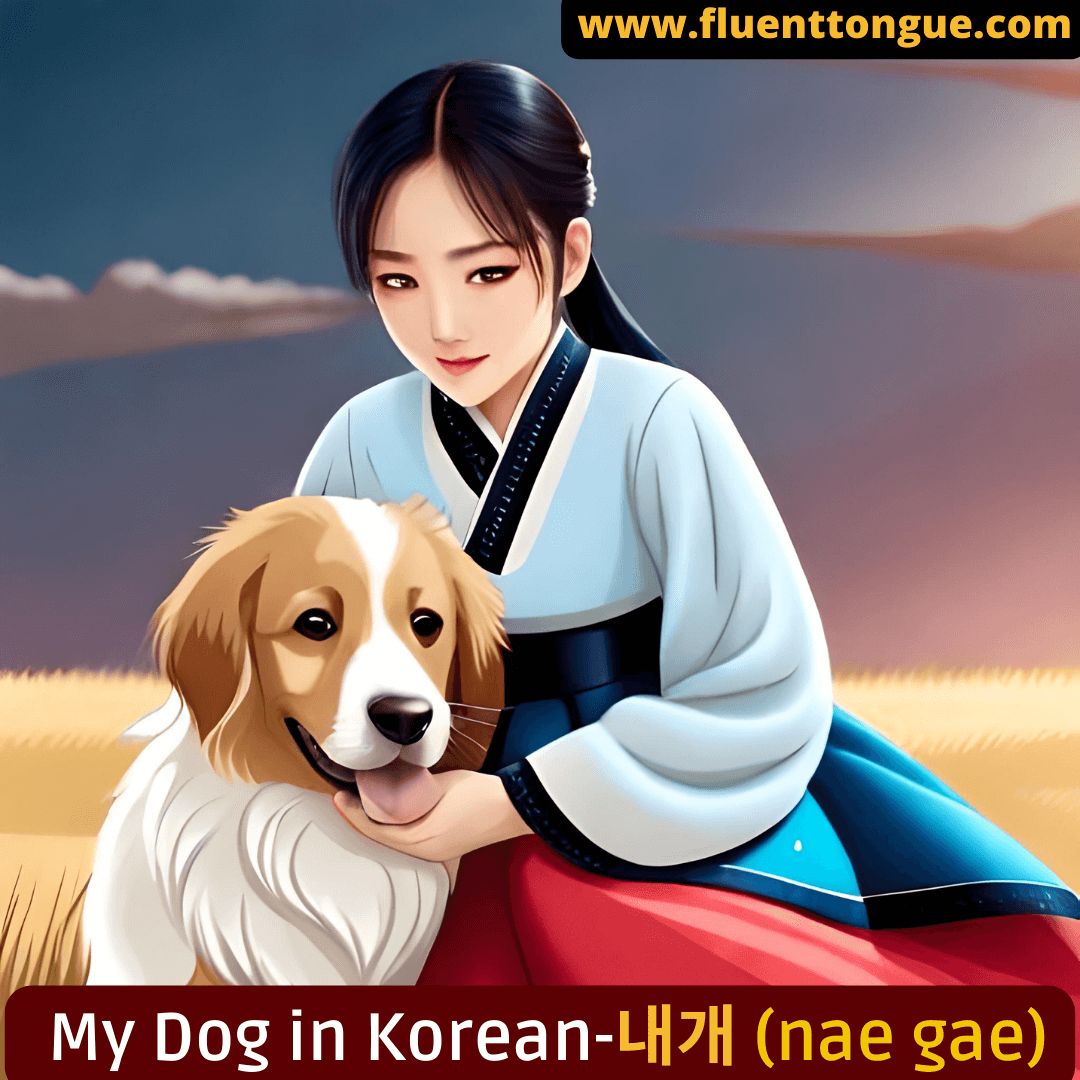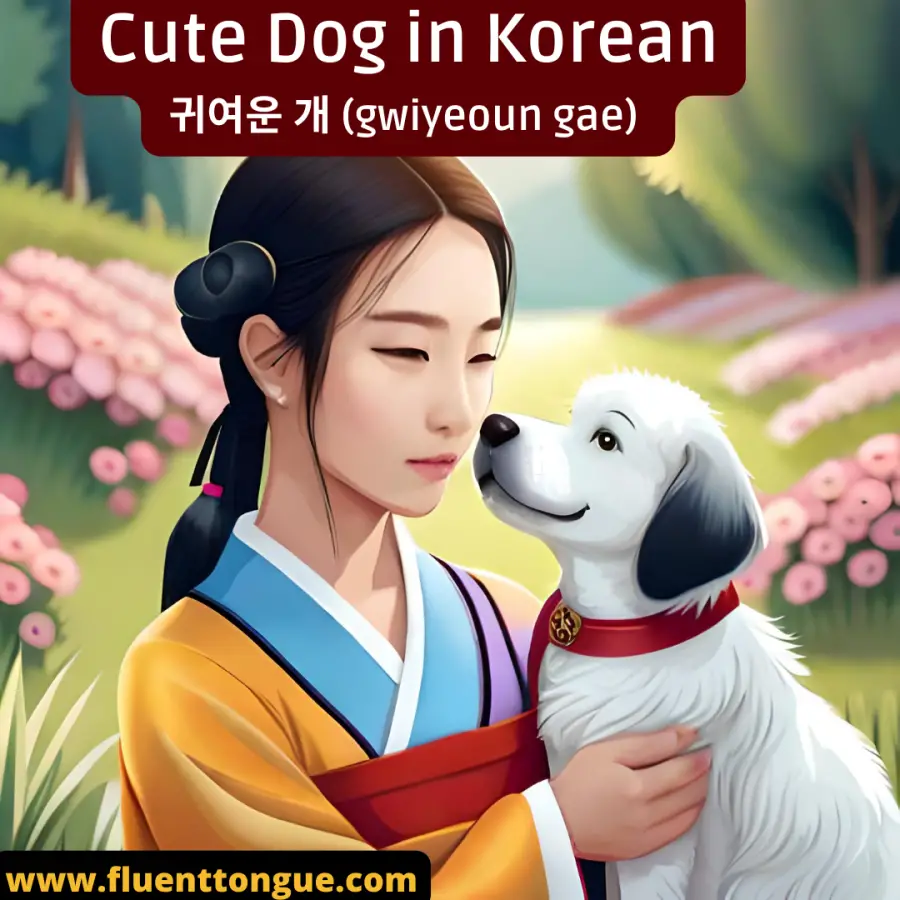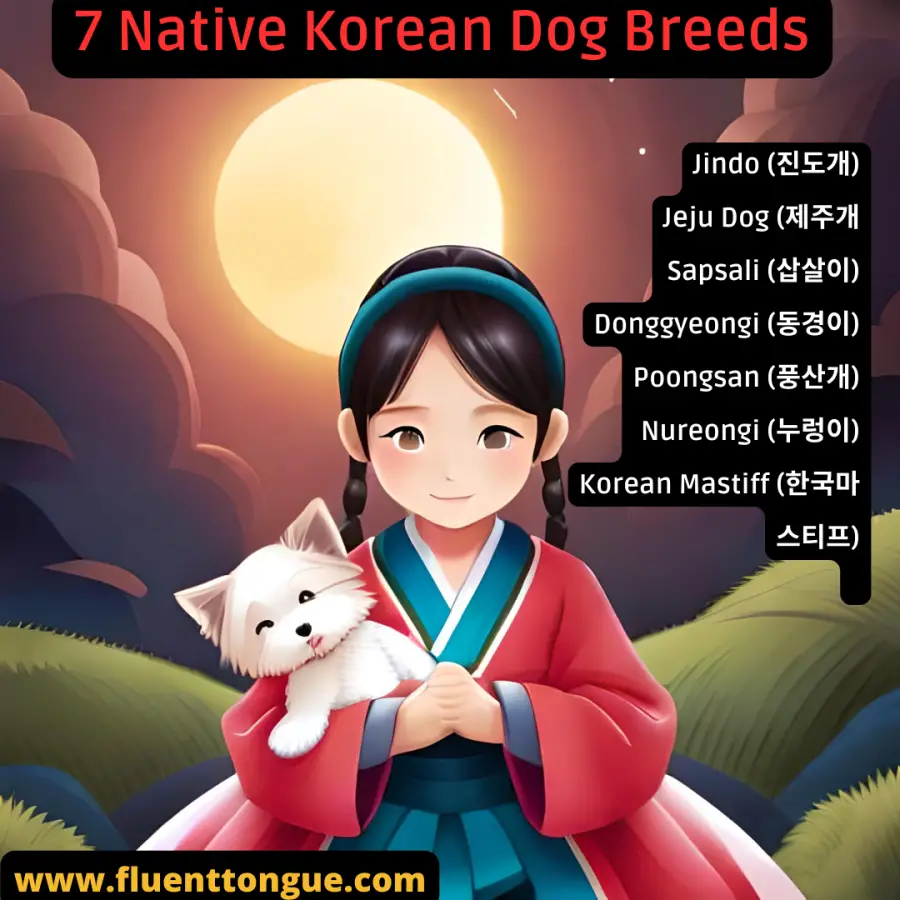For those who’re a canine lover or just seeking to study extra in regards to the Korean language, figuring out the best way to say canine in Korean is an ideal place to begin.
On this complete information, we are going to train you the best way to say “canine” in Korean, together with associated expressions, slang phrases, and even the best way to prepare your canine utilizing Korean instructions.
Get able to impress your mates and deepen your reference to Korean tradition.
Let’s dive in!
How one can say canine in Korean

The Korean phrase for “canine” is 개 (gae). In Korean, ‘canine’ can be translated as ‘강아지’ (gangaji) for the pet or a pet canine, and ‘개’ (gae) for the canine usually. It’s a easy, one-syllable phrase that’s simple to recollect.
Nevertheless, it’s essential to notice that 개 (gae) may also be used to depend models and items, so don’t get confused in case you see this phrase being utilized in a context as models, not animals
Listed here are 10 sentences utilizing ‘강아지’ (gangaji) and ‘개’ (gae):
강아지를 좋아해요? (Gangajileul joahae-yo?)
Do you want puppies?
저희 강아지가 매우 귀여워요. (Jeohui gangajiga maeu gwiyeowo-yo.)
Our pet could be very cute.
그 강아지는 어떤 종류에요? (Geu gangajineun eoddeon jonglyueyo?)
What breed is that pet?
내 강아지는 집에서 가장 재미있는 일이에요. (Nae gangajineun jibeseo gajang jaemiissneun ilieyo.)
My pet is probably the most enjoyable factor at house.
강아지가 산책을 좋아해. (Gangajiga sanchaeg-eul joahae.)
The pet likes to stroll.
개가 짖고 있어. (Gae-ga jjitgo iss-eo.)
The canine is barking.
그 개는 매우 크다. (Geu gae-neun maeu keuda.)
That canine could be very huge.
개를 어디서 구입할 수 있나요? (Gaeleul eodiseo guibhal su issnayo?)
The place can I purchase a canine?
개에게 먹이를 주세요. (Gae-ege meogileul juseyo.)
Please feed the canine.
개가 공원에서 놀고 있어. (Gae-ga gongwon-eseo nolgo iss-eo.)
The canine is enjoying within the park.
Bear in mind, when utilizing ‘개’ (gae), the time period may be much less affectionate or respectful in comparison with ‘강아지’ (gangaji).
Relying on the context and the extent of politeness required, you may choose to make use of ‘강아지’.
강아지 in Korean | How do you say pet in Korean?

In Korean, the phrase for “pet” is 강아지 (gangaji). This phrase is commonly used interchangeably with 개 (gae) to imply “canine.” 강아지 (gangaji) is extra informal and infrequently most popular when speaking about canines in on a regular basis dialog.
Listed here are 10 sentences utilizing ‘강아지’ (gangaji):
강아지는 정말 귀여워요. (Gangajineun jeongmal gwiyeowo-yo.)
Puppies are actually cute.
내 강아지의 이름은 루루예요. (Nae gangajiui ileum-eun Lulu-yeyo.)
My pet’s title is Lulu.
강아지를 어떻게 훈련시켜야 하나요? (Gangajireul eotteohge hunlyeonsikyeoya hanayo?)
How do I prepare a pet?
강아지가 집안을 더 즐겁게 만들어. (Gangajiga jiban-eul deo jeulgeobge mandeuleo.)
Puppies make the house extra fulfilling.
우리는 강아지를 입양하려고 합니다. (Ulineun gangajireul ibyangharyeogo habnida.)
We’re planning to undertake a pet.
그 강아지는 어떤 종류인가요? (Geu gangajineun eoddeon jonglyuingayo?)
What breed is that pet?
강아지를 좋아해요? (Gangajileul joahae-yo?)
Do you want puppies?
강아지가 밖에 나가고 싶어 보여. (Gangajiga bagge nagago sip-eo boyeo.)
The pet appears prefer it needs to go outdoors.
강아지는 많은 관심을 필요로 합니다. (Gangajineun manheun gwansimeul pil-yoro habnida.)
Puppies require plenty of consideration.
강아지는 아직 매우 작아요. (Gangajineun ajik maeu jag-a-yo.)
The pet continues to be very small.
Bear in mind, it’s essential to use respectful language when talking about pets, as they’re typically thought of a part of the household in Korean tradition.

Listed here are 5 Korean slang phrases/phrases associated to the phrase ‘canine’ (강아지 or 개 in Korean) together with their translations and examples:
멍멍이 (Mongmongi):
That is a cute approach of claiming ‘canine’, much like ‘doggie’ in English. This slang time period is an cute approach to discuss with a canine or pet, particularly when speaking to kids.
It’s derived from the Korean onomatopoeia for a canine’s bark, 멍멍 (meongmeong).
Instance:
네 멍멍이는 어디 있어요? (Ne mongmongineun eodi iss-eoyo?)
The place is your doggie?
멍멍이가 외로워 보여요. (Mongmongi-ga oelouwo boyeoyo.)
The doggie appears lonely.
개굿 (Gae intestine):
It’s slang used to specific one thing that’s actually good, it actually means “canine good”.
Instance:
이 식당은 개굿이다. (I sikdang-eun gaegut-ida.)
This restaurant is admittedly good.
네 옷 스타일 개굿이야. (Ne ot seutail gaegut-iya.)
Your model of garments is admittedly good.
개판 (Gaepan):
Actually means ‘canine mess’, used to explain a messy or chaotic scenario.
Instance:
내 방이 완전 개판이야. (Nae bang-i wanjeon gaepan-iya.)
My room is a complete mess.
이 프로젝트는 개판이 됐어. (I peulojegteuneun gaepan-i dwaess-eo.)
This mission has turn into a multitude.
개인적으로 (Gaeinjeogeuro):
Though circuitously associated to ‘canine’, ‘개인적으로’ accommodates the phrase ‘개’ and means ‘personally’.
Instance:
개인적으로 그 영화를 좋아해. (Gaeinjeogeulo geu yeonghwaleul joh-ahae.)
Personally, I like that film.
개인적으로 너를 도와주고 싶어. (Gaeinjeogeulo neoleul dowajugo sip-eo.)
Personally, I wish to enable you to.
개념없어 (Gaenyeom eobs-eo):
It actually means ‘no idea’, much like saying somebody has ‘no manners’ or ‘no widespread sense’.
Instance:
그는 정말로 개념없어. (Geuneun jeongmallo gaenyeom eobs-eo.)
He actually has no manners.
너 왜 그렇게 개념없어? (Neo wae geuleohge gaenyeom eobs-eo?)
Why are you so missing in widespread sense?
Bear in mind, slang can typically be casual or even impolite in sure contexts, so it’s essential to make use of these phrases appropriately in order that you gained’t be sorry to others.
Use the Korean phrase for the canine as a modified verb
The Korean language typically makes use of the phrase 개 (gae) as a modifier to emphasize the depth of a verb.
For instance, 개빠르다 (gaepalli) means “extraordinarily quick,” whereas 개많다 (gaemanta) means “quite a bit” or “very many.”
Word that this utilization is casual and must be reserved for informal conversations.
In Korean, the phrase for canine is “gae” (개). To make use of it as a modified verb, we are able to connect the verb-ending kind “-하다” (“-hada”) to “gae” to create a verb phrase.
Right here’s the components and a few quick instance sentences:
Formulation: Canine + -하다 (verb ending)
개하다 (gaehada) – to canine (verb), to behave like a canine
Instance sentence: 그 애는 항상 사람들을 쫓아다니면서 개해 (gaehae) 다녀요.
Translation: That child at all times runs round chasing folks and appearing like a canine.
개웃기다 (gaewoonggida) – to be dog-funny, to be humorous like a canine
Instance sentence: 그 코미디 배우는 정말로 개웃기게 (gaewoonggige) 연기를 해요.
Translation: That comedy actor performs in a approach that’s actually humorous like a canine.
개멋지다 (gaemeosjida) – to be dog-cool, to be cool like a canine
Instance sentence: 그 청년은 스타일이 정말로 개멋져 (gaemeosjyeo) 보여요.
Translation: That younger man has a method that appears actually cool like a canine.
개귀엽다 (gaegwiyeopda) – to be dog-cute, to be cute like a canine
Instance sentence: 그 아기는 입을 크게 벌리고 개귀엽게 (gaegwiyeopge) 웃어요.
Translation: That child opens their mouth vast and laughs in a cute approach like a canine.
Word: These modified verb types utilizing “gae” will not be generally utilized in on a regular basis Korean. They’re created right here for illustrative functions.
How one can say my canine in Korean

To say “my canine” in Korean, you merely add the possessive marker 의 (ui) to the phrase 개 (gae): 내 개 (nae gae).”나의” (naui) means “my” and “개” (gae) means “canine.” Merely mix them to say “my canine” in Korean.
Listed here are three quick and easy instance sentences utilizing “my canine”:
나의 개는 사랑스러워요. (Naui gae-neun sarangseurowoyo.)
My canine is cute.
나의 개는 충실하고 친절해요. (Naui gae-neun chungsilhago chinjeolhaeyo.)
My canine is loyal and pleasant.
나의 개는 매일 나를 기다리고 있어요. (Naui gae-neun maeil nareul gidarigo isseoyo.)
My canine waits for me on daily basis.
How one can say feminine canine in Korean

The Korean phrase for a feminine canine is 암컷 (amkeot). This time period is used to particularly discuss with the gender of the canine, similar to “bitch” in English.
How one can say I’ve a canine in Korean
To say “I’ve a canine” in Korean, you should utilize the phrase 개를 키우고 있어요 (gaereul giugo isseoyo), which accurately means “I’m elevating a canine.”
How one can prepare your canine in Korean

Coaching your canine utilizing Korean instructions is usually a enjoyable strategy to follow your language expertise and bond together with your furry pal.
Listed here are some widespread instructions in Korean to coach your canine :
- Sit: 앉아 (anja)
- Keep: 기다려 (gidaryeo)
- Come: 여기 (yeogi)
- Lie down: 누워 (nuwo)
- Shake: 손 (son)
- Fetch: 가지고 와 (gajigo wa)
- Heel: 따라와 (ttarawa)
How one can say cute canine in Korean

To say “cute canine” in Korean, you should utilize the phrase 귀여운 개 (gwiyeoun gae), the place 귀여운 (gwiyeoun) means “cute.”
Right here’s the breakdown:
- Gwiyeoun: This implies “cute” in Korean.
- Gae: That is the phrase for “canine” in Korean.
So, when mixed, “gwiyeoun gae” interprets to “cute canine” in English.
7 Native Korean Canine Breeds: Jindo, Jeju Canine & Extra

Korea is house to a number of native canine breeds, every with distinctive traits and historical past. Listed here are seven in style Korean canine breeds:
- Jindo (진도개): Korean jindo is Recognized for his or her loyalty and intelligence, Jindos are a medium-sized breed from Jindo Island.
- Jeju Canine (제주개): This uncommon breed from Jeju Island is thought for its robust searching instincts and pleasant nature.
- Sapsali (삽살이): With a shaggy coat and delicate temperament, Sapsalis make nice household pets.
- Donggyeongi (동경이): This historical breed from the Gyeongju area is thought for its distinctive, curled tail.
- Poongsan (풍산개): Bred for searching and guarding, Poongsans are giant, agile, and highly effective.
- Nureongi (누렁이): Also known as “yellow canines,” Nureongis have a particular golden coat.
- Korean Mastiff (한국마스티프): A big and highly effective breed, Korean Mastiffs are identified for his or her loyalty and protecting instincts.
50 lovely Korean names for Canines and puppies
Selecting a Korean title to your canine is usually a distinctive and significant strategy to honor Korean tradition. Listed here are 50 lovely Korean names for canines and puppies:
Actually! Listed here are 50 lovely Korean names for canines and puppies:
- Bomi (Stunning)
- Duri (Two)
- Gyeong (Revered)
- Haneul (Heaven)
- Jangmi (Rose)
- Yeonwoo (Swish)
- Bae (Inspiration)
- Dalkom (Candy)
- Gureum (Cloud)
- Hee (Grace)
- Jisoo (Loving)
- Yeji (Blessing)
- Miso (Smile)
- Seonmi (Kindhearted)
- Ara (Stunning)
- Nari (Lily)
- Haeun (Clear sky)
- Minji (Vivid and exquisite)
- Sarang (Love)
- Yuna (Swish)
- Choco (Chocolate)
- Jiyu (Freedom)
- Yuri (Lily)
- Bomi (Spring)
- Dalgi (Strawberry)
- Nuri (World)
- Haru (Day)
- Mia (Stunning little one)
- Sora (Sky)
- Chingu (Buddy)
- Gwangjang (Resplendent)
- Jisun (Knowledge)
- Yeon (Lotus)
- Heulim (Swish forest)
- Nabi (Butterfly)
- Duri (Two)
- Haeri (Sunshine)
- Mina (Purity)
- Seulgi (Knowledge and wonder)
- Yujin (Valuable pearl)
- Iseul (Morning dew)
- Jiwon (Mind and expertise)
- Yeong (Courageous)
- Byul (Star)
- Naeri (Flower)
- Sunmi (Goodness)
- Duri (Present)
- Aram (Stunning)
- Joohee (Light and shining)
- Yeonhwa (Lotus flower)
These names not solely sound lovely but in addition have significant translations.
Select the one which resonates together with your canine’s persona or look and luxuriate in calling them by their beautiful Korean title!
How one can study the phrase for canine in Korean simply?
Studying the phrase “canine” in Korean is comparatively simple. The phrase for canine in Korean is “gae” (개).
To simply memorize the phrase “canine” in Korean, strive utilizing it in actual sentences and training with native audio system or language studying apps. Associating the phrase with photographs of canines or utilizing mnemonic strategies also can assist with memorization.
Listed here are a couple of suggestions that will help you keep in mind it:
Pronunciation:
“Gae” is pronounced as “gae” with a mushy “g” sound, much like the “g” in “recreation.”
Visible Affiliation:
Strive creating a visible affiliation that will help you keep in mind the phrase. You possibly can image a cute canine whereas saying the phrase “gae” in your thoughts.
Observe:
Repeat the phrase “gae” a number of instances to familiarize your self with its pronunciation. You possibly can follow saying it out loud or write it down to bolster your reminiscence.
Vocabulary Constructing:
As you study extra Korean phrases, attempt to incorporate “gae” into easy sentences. For instance, you’ll be able to say, “I like canines” by utilizing the phrase “gae-reul joahae-yo” (개를 좋아해요).
Flashcards or Language Apps:
Make the most of flashcards or language studying apps that provide vocabulary workouts. They typically have audio recordings that may enable you to follow the proper pronunciation.
Bear in mind, follow and consistency are key to studying any language. With time and repetition, you’ll turn into extra snug with Korean vocabulary, together with the phrase “canine”.
Conclusion
Now that you simply’ve discovered the best way to say canine in Korean and numerous associated expressions, you’re effectively in your strategy to increasing your Korean vocabulary and impressing native audio system.
Whether or not you’re a canine proprietor, canine lover, or language learner, figuring out these phrases and phrases will enrich your understanding of Korean tradition and enable you to talk extra successfully.
Maintain training, and have enjoyable together with your newfound data!


